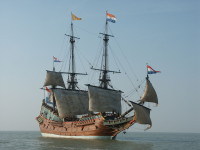The Batavia was a galleon that was in the service of the Dutch East India Company and sank on their first voyage off the coast of Australia.
Construction and launch :
March 17, 1626, the ship was commissioned as a so-called East India driver on the Peperwerft in Amsterdam. After 183,000 working hours, the ship was completed in 1628.
Mission:
The East India drivers were drafted by the Dutch East India Company into the Netherlands to transport weapons, bricks, silver and gold coins as well as soldiers and settlers in the Dutch colony on the property. On the way back the goods, textiles and Chinese ceramics are to be taken.
The first trip and the disaster:
The Batavia ran together with two other ships on October 29, 1628 from Texel from India. On the way in the Atlantic, however, the Batavia lost contact with the other ships and ran alone on 14 April 1629 the Cape of Good Hope, where it was 8 days left to record new supplies, then it went on to Australia.
Since at that time the navigation options were not yet so mature and the coastline with the adjacent shoals, currents and reefs were not fully mapped, the ship ran on 4 June 1629 60 kilometers west of the Australian coast on a reef of the Wallabi Islands. The disaster killed 20 people, the remaining survivors were able to save on the archipelago.
To get help, the chief merchant, the captain, and a select few sailors set off for Java on the larger lifeboat heading for Jakarta. Meanwhile, the under-salesman Jeronimus Cornelisz began to build a dictatorial reign of terror among the survivors and read about 125, including women and children, murder. Upon the return of the chief merchant, these could be warned by loyal soldiers who had saved themselves on a neighboring island, that the sub-merchant wanted to board the returned boats. Then he and several other mutineers were arrested and executed immediately. The rest of his accomplices were sent to jail, as was the captain in Jakarta.
In the 20th century, the sunken ship recovered the upper stern structure and the ballast cargo from carved sandstone blocks for a 6m high portal and can now be found in the museum in Geraldton, Australia.
This post is also available in:
 Deutsch (German)
Deutsch (German)  Français (French)
Français (French)  Italiano (Italian)
Italiano (Italian)  简体中文 (Chinese (Simplified))
简体中文 (Chinese (Simplified))  Русский (Russian)
Русский (Russian)  Español (Spanish)
Español (Spanish)  العربية (Arabic)
العربية (Arabic)











